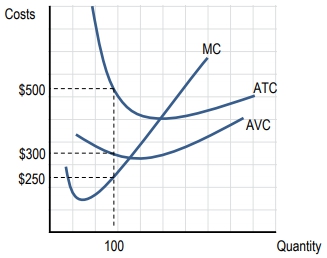Alright, so now let's take all the information we've learned about marginal cost, average fixed cost, average variable cost, and average total cost and put it all on the graph. Let's see what it looks like. Here, I have drawn for you one of the most important graphs in microeconomics. This is one of our most important graphs and it's showing us the four cost curves that we've been focusing on. It's showing us marginal cost, average fixed, average variable, and average total, right? So, we've got four curves there, and I'm going to help you with one, right? We've talked about marginal cost already and we've seen the curve previously. This curve right here, the black one, that's our marginal cost curve.
Knowing that, I want you guys to think about these other three curves: which one's average fixed cost, which one's average variable cost, and which one's average total cost. As a hint, try to pick out the average fixed cost curve first. Remember when we talked about the shapes of the curves, the average fixed cost had a different shape, right? Because it was always decreasing. The more quantity we produce, average fixed cost kept decreasing because the fixed cost stayed constant but we're splitting it up by more and more units. So which of these graphs has that shape? It's the blue one, constantly decreasing, right? This is our average fixed cost curve here, and it falls as the quantity increases.
Now, how about the other curves? The red curve and the yellow curve there are the other two. That's going to be our average variable cost and our average total cost. As a hint, think about which one is going to be bigger. Do you think average variable costs are going to be bigger or average total costs? Because there's one graph, one line here, that's always above the other. That means that the one above is our average total cost. Average variable cost could never be bigger than our average total cost because there's always going to be some fixed cost there as well, right? So, our total cost includes fixed cost and variable costs, so the average total cost has to be the top curve, right? It's going to be always above the other two average cost curves. This one has to be our average variable cost and average total cost is the yellow one.
So, there's some intuition on just how to pick out which curve is which. When I started, I told you which was the marginal cost curve, right? I told you and then had you pick out the average ones. But what if I hadn't told you? How could you pick that one out? Well, remember when we talked about marginal cost, the marginal cost eventually gets steep very fast. Notice how the marginal cost curve gets steep there at the end when the quantity got pretty big. The marginal cost just started zooming up. So, that's how you'll be able to identify it.
What we're going to do next is go down below. I've got some key facts that we want to point out about this graph. We've noticed that the marginal cost curve, average variable cost, and average total cost curve are U-shaped. They fall then rise. The average fixed cost has a different shape and keeps decreasing as the output increases, reflecting how fixed costs are divided across an increasing number of units, lowering the cost per unit.
An important relationship that you want to see between our three average curves, AFC, AVC, and ATC, is that there's always this space between the ATC and AVC. Remember, average total cost always equals average fixed cost plus average variable cost. This gap between ATC and AVC represents the average fixed cost. A key point here is that the distance between ATC and AVC gets smaller as we increase output because the average fixed costs become a smaller portion of total costs, as they are spread over a larger number of units.
Last thing we want to talk about is the relationship between marginal cost and average cost. How the marginal cost drives the average cost curves. If marginal cost is below average total cost, it will drive that average total cost down. The marginal cost curve is going to cross both the ATC and AVC at their minimum values. You can imagine that when the marginal cost is below, that's when we're going to see the ATC and AVC falling. Then, when marginal cost gets above ATC or AVC, they start rising. This graph is very important. Why don't you restart the video and now that you have all this information, watch this one again and see how it all fits now that you know what you're looking for. Let's go ahead and either watch it again or move on to the next one.


